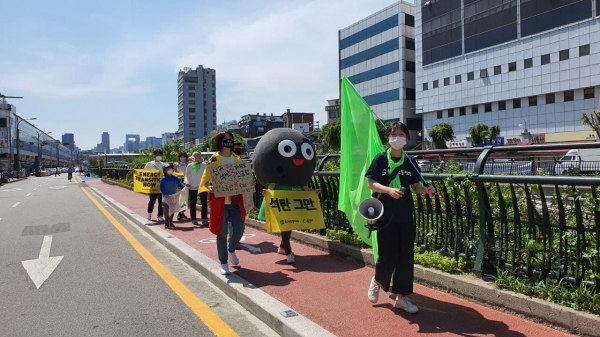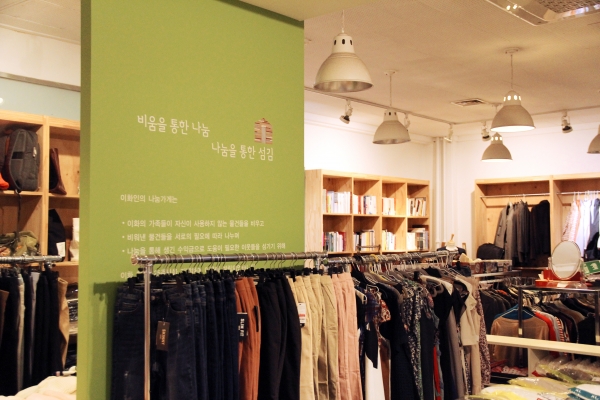On Aug. 31, 2021, South Korea became the 14th country to pass the bill on carbon neutrality. According to the Intergovernmental Panel on Climate Change, carbon neutrality is achieved when human-generated carbon dioxide emissions are balanced by actions that reduce carbon dioxide over a specific period. As South Korea has the 7th highest carbon dioxide emission level amongst OECD member countries, the South Korean government is working toward carbon neutrality. The recently legislated carbon neutrality act mandates that the government cut greenhouse gas emissions by at least 35 percent from the country’s 727 million metric tons of carbon dioxide by 2030. With the country paving the way toward carbon neutrality this year, Ewha Voice spoke to three different agents endeavoring in their own ways to reach the goal.
Korean Federation for Environmental Movements finds carbon neutrality act insufficient

The foundation of the Korean Federation for Environmental Movements (KFEM) dates back to April 1993. Environmental movements in the past were led mostly by the direct victims of pollution who resided near factories or construction sites.
The 1992 U.N. Conference on Environment and Development, however, prompted a wider range of people, including corporations, households, and students, to take interest in environmental issues. A number of environmental organizations were formed in Korea after the event and they were consolidated into the KFEM in 1993.
Jo Eun-ah, an activist with the KFEM’s Department of Energy and Climate Change, explained the newly legislated carbon neutrality act and what needs to be done.
The full title of Korea’s carbon neutrality act translates to “framework act on carbon neutrality and green growth” in English. Jo pointed out the first problem of the act from its title.
“We have entered an era where climate action and development cannot coexist,” Jo said. “This bill was proposed in order to deal with national and global climate change in the first place. However, to prioritize growth in times of crisis means the government is still eager to make developments despite the severe environmental consequences.”
Several articles within the act state that practical political means will be applied to reach carbon neutrality. Such means include the implementation of the climate change impact evaluation system. The system will be applied to national development plans and calculate what impact they will have on the climate at the time of proposal.
Another article mandated reviewing a national budget plan if it is suitable in attaining carbon neutrality. Jo clarified that the premise of the two articles is that the country will make plans and budgets that will impact the environment greatly.
Jo referred to the carbon neutral logging project conducted by the Korea Forest Service (KFS). Although the KFS announced that the organization has helped Cambodia reach carbon neutrality by slashing 650 thousand tons of green house gas, KFEM found out this was not true.
A research team at KFEM revealed that Cambodia’s forest size was in fact reduced by more than one-third by the KFS. Jo said that all development plans, although they may aim to create an eco- friendly society, have a serious impact on the environment.
Regarding Article 8 of the carbon neutrality act, which states the main objective to cut carbon dioxide emissions by at least 35 percent, Jo made clear the figure is far from enough to make a change.
Jo was aware that there are groups of people believing that the amendment of the law by a presidential decree would enable an aggressive maneuver toward reducing carbon dioxide emissions, and this holds true. Jo, however, said that 35 percent is an objectively low amount to make a change to the environment. Activists and researchers see a 50 percent reduction as the minimum required to make a step toward carbon neutrality in Korea by 2030.
Nevertheless, Jo saw some prospects in the bill as well. The act provides a climate fund, which would be used to support changes in industrial models and processes. Jo expressed that this is significant because there will be money provided solely for structural change.
“South Korea has had a late start in climate change actions compared to the United States or Europe,” Jo said. “Considering that the country has just started carbon-neutral activities on a national level, it is time we, including students at Ewha, pay attention to the country’s activities and pursue carbon neutrality together.”
Ewha endeavors to achieve carbon neutrality on campus through second-hand goods

Ewha Nanum Shop, a store that sells second-hand goods on campus, was established in commemoration of Ewha’s 125th anniversary in 2011. Founded upon the school’s mission to worship and share, the shop aims to promote the use of second-hand goods within the Ewha campus.
Youn Sung-hee, a project planning and general affairs team manager at Ewha Coop, has been in charge of operating the Ewha Nanum Shop since its establishment.
“I have been doing this job since 2011, so I marked my 10th anniversary with Ewha Nanum Shop this May,” Youn said. “Before COVID-19, the shop collected around 10,000 used items every year, and all the profits made from Ewha Nanum Shop have been given to students as a scholarship.”
Among the donated goods, those that do not find new owners after a lengthy period are sent to single-parent families, out-of-school youths, and churches supporting elderly residents in Sinchon.
Although the act of reselling used goods to those who need them is meaningful enough, reusing clothes and goods is also worthwhile in creating a carbon neutral society.
According to Secondary Materials and Recycling Textiles (SMART), up to 95 percent of the textiles that go into landfills are of pristine quality and could be reused. SMART also indicated that fashion and clothing brands should be required to reuse clothes as the fashion industry contributes to more than 10 percent of global carbon dioxide emissions.
With the need for fashion industries to make a carbon neutral change, Youn pointed out that SPAO and MIXXO, two Korean clothing brands, have recently donated many of their products to Ewha Nanum Shop. Those who are interested in purchasing second-hand goods and clothes should visit the Ewha Nanum Shop located in the school’s Alumnae Building, from 10 a.m. to 4 p.m. during weekdays.
Green Technology Center’s effort to enhance eco-friendly technology
Setting up the basic green technologies and infrastructures to drive the change, the Green Technology Center (GTC) plays a significant role in managing carbon dioxide emissions and climate change.
GTC is a government-funded research institute attached to the Ministry of Science and ICT. It supports the establishment of policies by conducting research on climate change and green technology. The GTC has carried out practical projects with governments and committees to develop green technologies in Korea and overseas since 2017.
Son Ji-hee, a senior researcher from the GTC, dedicates herself to the work of creating technological cooperation with the international community. Son’s main research features work based on the Climate Technology Centre & Network (CTCN). CTCN is an operational arm of the United Nations Framework Convention on Climate Change (UNFCCC), the treaty that imposed different responsibility depending on whether a country is developed or developing.
When South Korea first signed up for the UNFCCC, it was classified as a developing country, freeing itself from the obligation to provide technical assistance to other developing countries on green technology. However, as the UNFCCC was extended to the Paris Climate Agreement, South Korea was urged to take constructive action to support developing countries. Accordingly, Son and her colleagues engaged in research and participated in practical programs to inform developing countries about green technology mechanisms through the CTCN.
Son explained several projects based on CTCN-relevant businesses, such as the Green Transportation Supporting Business which were supported by the GTC. This allowed many developing countries including Cambodia and Bhutan to acquire crucial technologies to operate transportation systems with low carbon emissions.
GTC also collaborated with small and medium-sized firms in Korea to build solar-powered drinking water supply systems in developing countries. Numerous countries including Tanzania were the beneficiaries of the GTC’s project, significantly reducing carbon emission and simultaneously securing drinking water.
Son also shared her opinion on the newly legislated carbon neutrality act.
“Unlike other developed countries, which have taken steps toward reducing carbon emissions that looked far ahead and progressed at a slow pace, South Korea needs to meet the international goal in a relatively short amount of time,” Son said. “To industries that focus on manufacturing, the new greenhouse gas emission reductions can seem harsh. On the other hand, environmental organizations find these targets insufficient to slow down climate change. Still, it is necessary to form a consensus between various subjects.”
To reach a new standard, Son believes that the carbon-neutral technologies that have been developed need to be put into practice in industrial sites. Son also points out that it is not appropriate to rush the process of technical development and expect entirely new technology to instantly appear.
Being a researcher who provides information about green technology to policy-making bodies, Son feels rewarded when she sees her research being a foundation for the policies.
“When my research can drive small changes in climate change, I feel that what I have done is worthwhile,” Son concluded.

